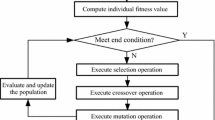Abstract
To deal with the multi-objective optimization problems (MOPs), this study proposes a new Multi-Objective Multi-Agent Complex Network Optimization Algorithm called MOMCNA based on the idea of Cellular genetic algorithm (CGA) and the Multi-agent complex network. Compared with the traditional CGA for multi objective problem, the individuals in the population of MOMCNA have more features of intelligent agent, the new form of neighborhood for the population, private archive for individuals, the new strategy of “local-global” genetic operator and the chaotic mutation are proposed in the new algorithm to balance the convergence and diversity of the algorithm. Seventeen unconstrained multi-objective optimization problems and seven many-objective problems are introduced and tested to evaluate the new algorithm, in addition, the classical traffic assignment problem based on different system optimum principle is also established to evaluate the new algorithm. The comparison between MOMCNA and other classical algorithms shows that the proposed MOMCNA proves to be competitive in dealing with multi-objective and many-objective optimization problems and the structure of the complex network made up of population also has effect on algorithm’s performance.













Similar content being viewed by others
References
Deb K, Pratap A, Agarwal S et al (2002) A fast elitist multi objective genetic algorithm: NSGA-II. IEEE Trans Evol Comput 6(2):182–197
Zhang Q, Liu W, Li H. The performance of a new version of MOEA/D on CEC09 unconstrained MOP test instances, 2009 IEEE congress on evolutionary computation, Trondheim, 203-208, (2009)
Yen GG, Lu H (2003) Dynamic multi objective evolutionary algorithm: adaptive cell-based rank and density estimation. IEEE Trans Evol Comput 7(3):253–274
Liu J, Zhang H, He K et al (2018) Multi-objective particle swarm optimization algorithm based on objective space division for the unequal-area facility layout problem. Expert Syst Appl 102:179–192
Liu HT, Du W, Guo ZX (2019) A multi-population evolutionary algorithm with single-objective guide for many-objective optimization. Inf Sci 503:39–60
Sağ T, Cankuş M (2016) A new ABC-based multi objective optimization algorithm with an improvement approach (IBMO: improved bee colony algorithm for multi objective optimization). Turk J Electr Eng Comput Sci 24(4):2349–2373
Luo J, Liu Q, Yang Y et al (2017) An artificial bee colony algorithm for multi-objective optimisation. Appl Soft Comput 50:235–251
Kaur M, Kadam S (2018) A novel multi-objective bacteria foraging optimization algorithm (MOBFOA) for multi-objective scheduling. Appl Soft Comput 66:183–195
Babalik A, Ozkis A, Uymaz SA et al (2018) A multi-objective artificial algae algorithm. Appl Soft Comput 68:377–395
Luo J, Yang Y, Liu Q et al (2018) A new hybrid memetic multi-objective optimization algorithm for multi-objective optimization. Inf Sci 448:164–186
Li WK, Wang WL, Wang Z et al (2019) Opposition-based Multi-Objective Whale Optimization Algorithm with Global Grid Ranking. Neurocomputing 341:41–59
Nematollahia AF, Rahiminejadb A (2019) Vahidi B A novel multi-objective optimization algorithm based on Lightning Attachment Procedure Optimization algorithm. Appl Soft Comput 75:404–427
Yang S, Li M, Liu X et al (2013) A grid-based evolutionary algorithm for many-objective optimization. IEEE Trans Evol Comput 17(5):721–736
Jie L, Liu W, Sun Z et al (2017) Hybrid fuzzy clustering methods based on improved self-adaptive cellular genetic algorithm and optimal-selection-based fuzzy c-means. Neurocomputing 249:140–156
Nebro AJ, Durillo JJ, Luna F et al (2007) Design Issues in a Multi objective Cellular Genetic Algorithm. In: Obayashi S, Deb K, Poloni C, Hiroyasu T, Murata T (eds) Evolutionary Multi-Criterion Optimization. EMO 2007. Lecture notes in computer science, vol 4403. Springer, Berlin, Heidelberg
Nebro AJ, Durillo JJ, Luna F et al (2009) MOCell: A cellular genetic algorithm for multi objective optimization. Int J Intell Syst 24(7):726–746
Lu C, Gao L, Pan Q et al (2019) A multi-objective cellular grey wolf optimizer for hybrid flowshop scheduling problem considering noise pollution. Appl Soft Comput 75:728–749
Zheng J, Lu C, Gao L (2019) Multi-objective cellular particle swarm optimization for wellbore trajectory design[J]. Appl Soft Comput 77:106–117
Zhang H, Song S, Zhou A et al (2015) A multi objective cellular genetic algorithm based on 3D structure and cosine crowding measurement. Int J Mach Learn Cybern 6(3):487–500
Saxena A (2019) A comprehensive study of chaos embedded bridging mechanisms and crossover operators for grasshopper optimisation algorithm. Expert Syst Appl 132:166–188
Watts DJ, Strogatz SH (1998) Collective dynamics of small world networks. Nature 393(6684):440–442
Schimit PHT, Santos BO, Soares CA (2015) Evolution of cooperation in Axelrod tournament using cellular automata. Phys A: Stat Mech Appl 437:204–217
Ruan Y, Li A (2016) A new small-world network created by cellular automata. Phys A: Stat Mech Appl 456:106–111
Deb K, Thiele L, Laumanns M et al (2005) Scalable test problems for evolutionary multiobjective optimization. In: Abraham A, Jain L, Goldberg R (eds) Evolutionary multiobjective optimization. Advanced Information and Knowledge Processing. Springer, London
Zhang Y, Gong DW, Ding Z (2012) A bare-bones multi-objective particle swarm optimization algorithm for environmental/economic dispatch. Inf Sci 192(6):213–227
Mirjalili S, Jangir P, Mirjalili SZ et al (2017) Optimization of Problems with Multiple Objectives using. The Multi-Verse Optimization Algorithm Knowledge-Based Systems 134:50–71
Sheffi Y (1984) Urban transportation networks: equilibrium analysis with mathematical programming methods. Prentice-Hall
Raith A, Wang JYT, Ehrgott M et al (2014) Solving multi-objective traffic assignment. Ann Oper Res 222(1):483–516
Péres M, Ruiz G, Nesmachnow S et al (2018) Multi objective evolutionary optimization of traffic flow and pollution in Montevideo. Uruguay Appl Soft Comput 70:472–485
Kolak OI, Feyzioglu O, Noyan N (2018) Bi-level multi-objective traffic network optimisation with sustainability perspective. Expert Syst Appl 104:294–306
Acknowledgments
This work was supported by project of science and technology research and development plan of China National Railway Group Co., Ltd. (grant numbers: K2019Z006), Beijing Social Science Foundation (grant numbers: 19ZDA05 and 19YJB016).
Author information
Authors and Affiliations
Corresponding author
Additional information
Publisher’s note
Springer Nature remains neutral with regard to jurisdictional claims in published maps and institutional affiliations.
Rights and permissions
About this article
Cite this article
Li, X., Zhang, H. A multi-agent complex network algorithm for multi-objective optimization. Appl Intell 50, 2690–2717 (2020). https://doi.org/10.1007/s10489-020-01666-8
Published:
Issue Date:
DOI: https://doi.org/10.1007/s10489-020-01666-8




